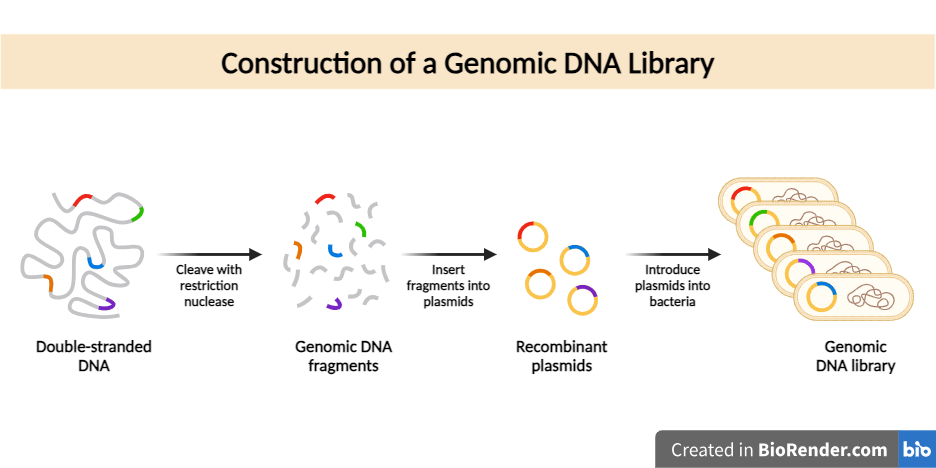Introduction:
cDNA library is a population of bacterial transformation or phage lysates in which each mRNA isolated from an organism or tissues is represented as its cDNA insertion in a plasmid or a phage vector. The frequency of a specific cDNA in such a library would ordinarily depend on the frequency of the concerned mRNA in the tissue/organism in question.
Steps:
Isolation of mRNA
For isolation of mRNA, total NA is first extracted from a suitable organism or tissue. The desired mRNA in this sample is then increased by several procedures. Moreover, the protocol for isolation of the mRNA is also dependent upon the kits that one is following.
Affinity chromatography is applied in order to retain mRNA molecules using 3’poly-A tails; this enriches the preparation with mRNA.
Density gradient centrifugation is also applied in order to increase the concentration of desired mRNA molecules.
Preparation of cDNA
cDNA refers to the copy or complementary DNA which is synthesized by using mRNA as a template. In fact, any RNA molecule can be used to produce cDNA by the enzyme RNA-dependent DNA polymerase known as reverse transcriptase.
The enzyme reverse transcriptase was discovered by Temin and Baltimore in 1970 which is generally obtained from avian myeloblastosis virus (AMV) which works in the similar fashion as DNA polymerase.
Eukaryotic mRNA is used as a template and is conveniently used as a primer. In the presence of enzyme reverse transcriptase 3’ end of the primer is extended. This produces an RNA-DNA hybrid molecule; the DNA strand of this hybrid is obviously the DNA copy (cDNA) of the mRNA strand. The RNA is digested using RNase H and eventually, the remaining cDNA will serve as its primer for the synthesis of complementary strands.

Fig: Construction of a cDNA Library
Incorporation of cDNA into a vector and cloning of cDNAs
cDNAs are usually cloned in phage insertion vectors because they afford high efficiency packaging in vitro and as a result give large numbers of cDNA clones. Typically, 105-106 cDNA clones are sufficient for the isolation of low abundance mRNAs that are present at about 15 molecules per cell or above. Restriction endonucleases and DNA ligase are utilized to clone the plasmid-confined cDNA within the host cell.
In case, the mRNA of interest is led than this, it is advisable to enrich the mRNA preparation before library construction. One way to do is by size fractionation coupled with testing the various fractions for the presence of desired mRNAs, e.g., by injecting the mRNAs into Xenopus oocytes and assaying for the protein product of the concerned mRNA.
The cloned bacteria are subsequently selected, most typically using antibiotic selection. Once selected, bacterium stocks are produced, which can then be cultured and sequenced to complete the cDNA library.
Properties of cDNAs and cDNA libraries:
- Eukaryotic cDNAs are free from intron sequences.
- The contents of cDNA libraries from a single organism will vary depending on the developmental stage and the cell type used for preparation of the library. In contrast, the genomic libraries will be substantially the same regardless of the developmental stage or cell type used.
- A cDNA library will be enriched for abundant mRNAs, but may contain only few or no clones representing rare mRNAs.
- A comprehensive library includes all relevant sequences and full-length cDNA inserts from the original mRNA and it provide important information for understanding gene expression and processing.
Applications of cDNA library:
- The cDNA library is a powerful and useful tool in the area of biotechnology that aid in expressing both eukaryotic and prokaryotic genes which is needed for the detection of the clone and polypeptide product.
- It is used to isolate DNA sequences to code mRNA that is used for the screening genomic libraries to isolate specific cDNA.
- Isolation of homologous genes that eventually facilitate to generate antibodies and monoclonal antibodies.
- The most important application of cDNA library is to study expression of mRNA in different cells or tissues. In addition, to study the alternative splicing of different cells or tissues.
